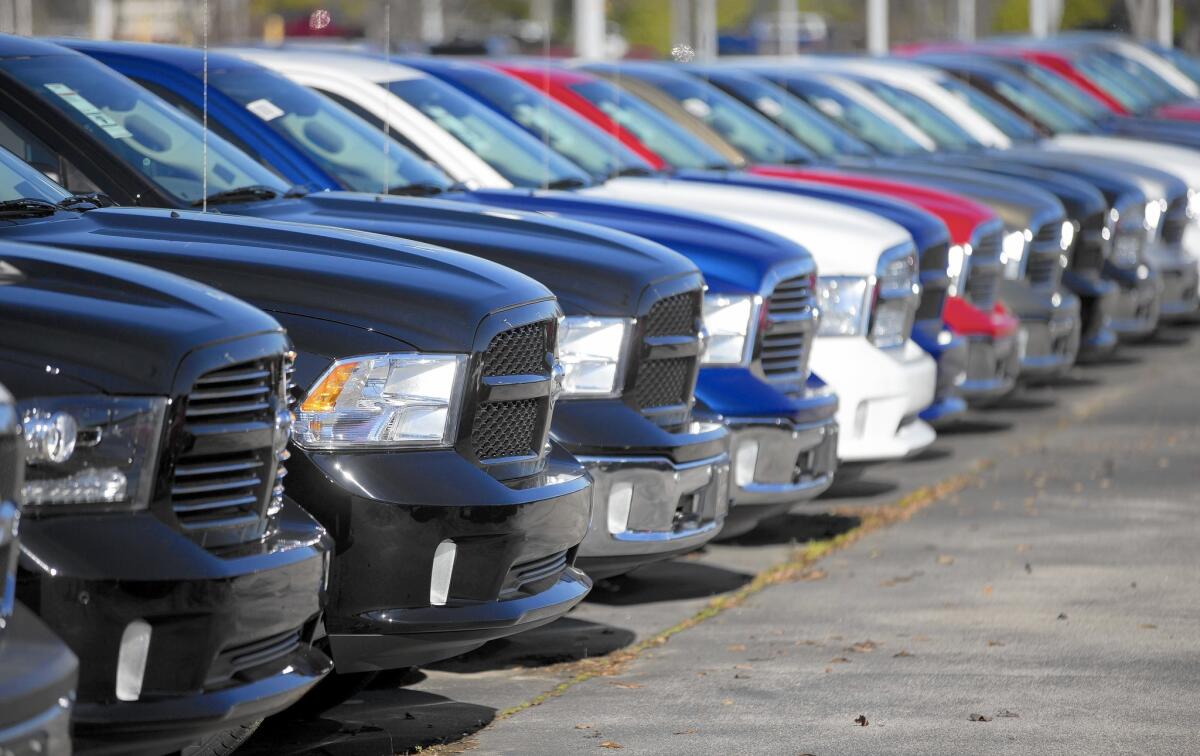Auto sales soar in December as industry has best year since 2006

Americans bought 16.5 million vehicles last year as low interest rates, longer loan terms and falling gas prices pulled shoppers into dealerships. It was the industry’s best year since 2006.
The strong performance by automakers underscored how the industry continues to be one of the bright spots of the U.S. economy. New-vehicle sales accounted for $526 billion in revenue last year, almost an 8% gain from the prior year, according to car shopping company TrueCar.
Sales of “highly profitable vehicle segments — pickups, utilities and luxury vehicles — have been immensely beneficial to automakers,” said John Krafcik, president of TrueCar.
With sales gains, the industry has been adding factory shifts and hiring workers.
Automaker employment rose 47,700 last year, a 7% increase over the prior year, according to the Center for Automotive Research. The industry now employs 733,800 workers in the U.S., climbing back to levels not seen since before the recession in 2008.
Much of the recovery has been in the traditional auto industry regions, including Michigan, Indiana and Ohio, said Kristin Dziczek, director of the industry and labor group at the Center for Automotive Research.
Most auto companies expect auto sales to rise again this year, but by an amount considerably less than the increase of roughly 1 million vehicles the industry has experienced annually since 2009.
Toyota estimates total 2015 U.S. car sales at 16.7 million.
“That would be the industry’s best in 10 years with some room for upside,” said Bill Fay, Toyota Division group vice president.
Some forecasters believe that sales could crack 17 million this year, which would be the highest since 2001. The industry sold 15.6 million vehicles in 2013.
“Consumers will continue to replace aging vehicles with newer and better models,” Standard & Poor’s credit analyst Nishit Madlani said. “The combination of relatively low interest rates and some cash rebates for vehicle purchases should also boost sales.”
December was one of the best months of the year, with automakers selling 1.5 million vehicles, 10.8% more than in the same month a year earlier, according to Autodata Corp.
“Everything you need to have a great month was in place: Consumers felt good about the direction of the economy, interest rates and fuel prices were low,” said Kurt McNeil, General Motors’ U.S. vice president of sales operations.
GM sold 274,483 vehicles in the U.S. in December, up 19.3% from the same month a year earlier, Autodata said. Its annual sales rose 5.3% to more than 2.9 million.
Ford sold 219,369 vehicles last month, up 1.3% from a year ago and the company’s best December since 2005. But its sales for the entire year slid about 14,000 vehicles to just under 2.5 million. Ford blamed the decline on falling truck sales caused by the changeover to a new design for its F-150 pickup truck and a planned reduction in sales to rental car companies.
FCA US, which operates the Chrysler, Jeep, Ram and Fiat brands in the U.S., said its December sales reached 193,261 vehicles, a 20% increase over the same month a year earlier and the company’s best December sales since 2004.
Bolstered by Jeep, which with a 41% gain was the fastest-growing major brand in the U.S. last year, FCA posted annual sales of almost 2.1 million vehicles, up 16.1%.
The domestic auto companies finished the year with 45.2% of the market, the same amount they held in 2013.
Toyota’s December sales rose 12.7% to 215,057 vehicles. For the year, the automaker sold almost 2.4 million vehicles, a 6.2% gain.
Honda sold 137,281 vehicles last month, up 1.5%. Annual sales rose 1% to more than 1.5 million. It was Honda’s second-best sales year in the U.S.
Nissan said its December sales rose 6.9% to 117,318 units, its best December ever. Nissan also set an annual sales record, moving nearly 1.4 million vehicles, an 11.1% gain from the prior year.
Subaru was the fastest-growing major automaker in the U.S. last year. It sales rose 21% and it crossed the 500,000 mark for the first time.
Bolstered by Subaru and Nissan, Asian automakers now hold 45.4% of the U.S. auto market, up from 45.1% in 2013, according to Autodata. Most of that gain came from Ford and the European brands.
Despite a sales decline, Ford’s F-150 pickup truck repeated as the nation’s most popular vehicle. The Camry, Toyota’s family sedan, was the bestselling passenger car last year. BMW sold the most luxury cars in the U.S., narrowly edging out Mercedes-Benz. Lexus was a close third.
Although many analysts believe that U.S. auto sales will continue to rise, others say the era of robust growth is coming to a close.
“While 2014 definitely ended in a cheery mood, the year-over-year sales gain was not as great as in past recent years,” said Eric Ibara, an analyst at auto information company Kelley Blue Book. “2015 will likely be a transitional period where new-car sales plateau or perhaps even take a small dip.”
Low interest rates and longer loan terms — the average car loan is more than 66 months — are coaxing consumers to buy cars sooner than they would have otherwise. With cars lasting longer and loans stretching to seven years or more, these consumers won’t be back in the auto market for years, some analysts are predicting.
“U.S. auto sales are dancing to a very different, and we believe unsustainable, beat,” said Adam Jonas, an analyst with Morgan Stanley Research.
He said that easy credit is providing much of the fuel for the current car sales boom, but that longer-term trends such as declining number of America’s young people getting a driver’s license could spell trouble for the industry in the future.
Despite recent gains, the industry remains a cyclical business, said Mark Wakefield, who heads the automotive practice at AlixPartners.
The consulting firm forecasts increased sales this year and next, but it won’t “keep on going onward and upward,” he said. “2017 starts a downturn as interest rates rise and consumers have less purchasing power.”
Twitter: latimesjerry







